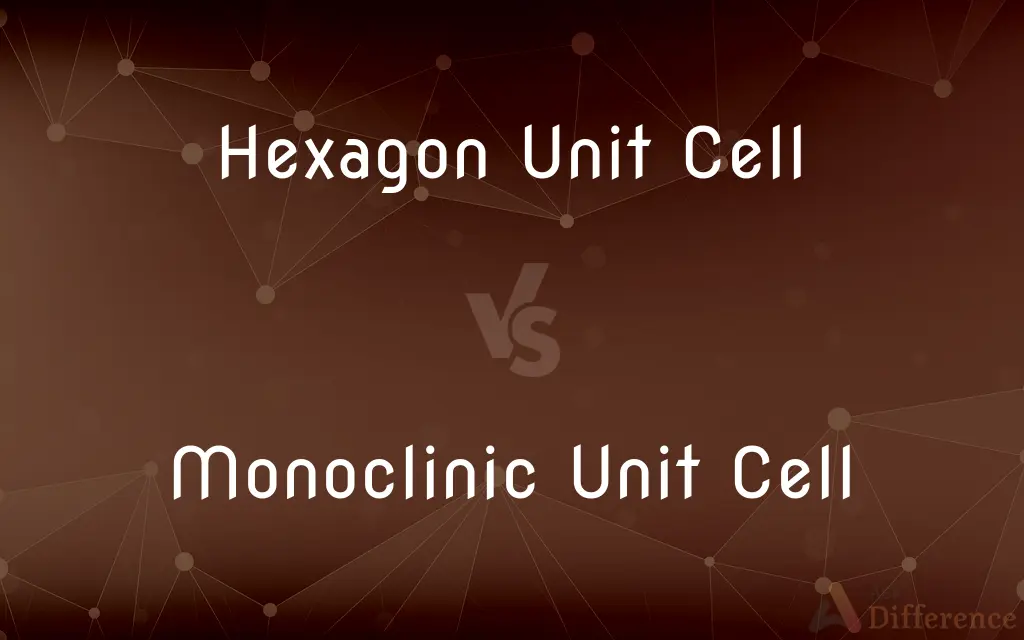Hexagon Unit Cell vs. Monoclinic Unit Cell — What's the Difference?
By Tayyaba Rehman — Published on December 18, 2023
A Hexagon Unit Cell is six-sided and symmetrical, while a Monoclinic Unit Cell has three unequal axes with one not at right angles.

Difference Between Hexagon Unit Cell and Monoclinic Unit Cell
Table of Contents
ADVERTISEMENT
Key Differences
Hexagon Unit Cell and Monoclinic Unit Cell both refer to types of crystalline structures, albeit with different geometries. The Hexagon Unit Cell, as its name implies, is six-sided and showcases a symmetry found in hexagonal systems. On the other hand, the Monoclinic Unit Cell belongs to a system that's characterized by three unequal axes, where only two are perpendicular.
In terms of symmetry, the Hexagon Unit Cell displays a higher level due to its six equal sides. This is a sharp contrast to the Monoclinic Unit Cell, which lacks such symmetry due to its distinct and unequal axes. Both these cells, however, are integral to understanding the layout of atoms or molecules in a crystal.
When studying crystals, the Hexagon Unit Cell often relates to materials like graphite or some minerals. The Monoclinic Unit Cell, with its unique axes arrangement, can be found in certain types of minerals and other crystalline substances. Both these cells provide insights into the atomic arrangements within substances.
In crystallography, the Hexagon Unit Cell and the Monoclinic Unit Cell represent different lattice systems. While the hexagonal is more symmetrical, the monoclinic system offers a unique, less regular arrangement. Understanding both is crucial for those delving into the realm of materials science and crystallography.
Comparison Chart
Shape
Six-sided and symmetrical
Three unequal axes, two at right angles
ADVERTISEMENT
Symmetry
High symmetry due to six equal sides
Lower symmetry due to unequal axes
Commonly Found In
Minerals like quartz, and materials like graphite
Certain types of minerals
Axes Arrangement
Three equal axes at 120 degrees
Three axes, only two of which are perpendicular
Lattice System
Hexagonal
Monoclinic
Compare with Definitions
Hexagon Unit Cell
A basic repeating unit in hexagonal systems.
The Hexagon Unit Cell determines the properties of certain minerals.
Monoclinic Unit Cell
A basic repeating unit in monoclinic systems.
The properties of certain minerals are determined by the Monoclinic Unit Cell.
Hexagon Unit Cell
A lattice system characterized by three equal axes intersecting at 120 degrees.
The Hexagon Unit Cell displays a unique angular relationship between its axes.
Monoclinic Unit Cell
A representation of atomic arrangements with less regularity.
The Monoclinic Unit Cell showcases a distinct layout of molecules in a crystal.
Hexagon Unit Cell
A crystalline structure with six equal sides.
The graphite in your pencil is arranged in a Hexagon Unit Cell.
Monoclinic Unit Cell
A unit of the monoclinic lattice system in crystallography.
Gypsum has a Monoclinic Unit Cell structure.
Hexagon Unit Cell
A representation of atomic or molecular arrangement in some crystals.
The layout of atoms in some minerals can be described by the Hexagon Unit Cell.
Monoclinic Unit Cell
A cell characterized by one oblique angle in its geometry.
The Monoclinic Unit Cell's distinct shape comes from its one non-perpendicular axis.
Hexagon Unit Cell
A symmetrical unit in crystallography due to its identical sides.
Quartz has a Hexagon Unit Cell, giving it a symmetrical appearance.
Monoclinic Unit Cell
A crystalline structure with three unequal axes, two at right angles.
The Monoclinic Unit Cell is unique due to its unequal sides.
Common Curiosities
Are the Hexagon Unit Cell and Monoclinic Unit Cell found in the same materials?
No, they represent different lattice systems and are found in different materials.
What differentiates a Monoclinic Unit Cell?
It has three unequal axes, with only two being perpendicular.
Can I find the Monoclinic Unit Cell in graphite?
No, graphite is arranged in a Hexagon Unit Cell.
What's the primary distinction between the two unit cells?
The Hexagon Unit Cell is symmetrical with six equal sides, while the Monoclinic Unit Cell has three unequal axes with one oblique angle.
What is a Hexagon Unit Cell?
It's a six-sided symmetrical unit in crystallography representing atomic or molecular arrangements.
Hexagon Unit Cell or Monoclinic Unit Cell?
The Hexagon Unit Cell has higher symmetry due to its six equal sides.
How do the axes of the Hexagon Unit Cell intersect?
They intersect at 120 degrees.
In which crystals is the Monoclinic Unit Cell commonly found?
It's found in certain types of minerals, like gypsum.
Why is the shape of the Hexagon Unit Cell important?
Its shape determines the properties and behavior of certain minerals and materials.
What's unique about the Monoclinic Unit Cell's axes?
It has three axes, but only two are at right angles.
How does the Hexagon Unit Cell impact material properties?
Its symmetrical structure can influence mechanical, electrical, and optical properties of the material.
Is the Hexagon Unit Cell related to the hexagonal lattice system?
Yes, it's a basic repeating unit in hexagonal systems.
Is the Monoclinic Unit Cell less regular than the Hexagon Unit Cell?
Yes, due to its unique and unequal axes.
Do all crystals have either a Hexagon Unit Cell or a Monoclinic Unit Cell?
No, there are other unit cell types in crystallography.
Share Your Discovery

Previous Comparison
Vomit vs. Spit Up
Next Comparison
Manta Ray vs. StingrayAuthor Spotlight
Written by
Tayyaba RehmanTayyaba Rehman is a distinguished writer, currently serving as a primary contributor to askdifference.com. As a researcher in semantics and etymology, Tayyaba's passion for the complexity of languages and their distinctions has found a perfect home on the platform. Tayyaba delves into the intricacies of language, distinguishing between commonly confused words and phrases, thereby providing clarity for readers worldwide.
















































